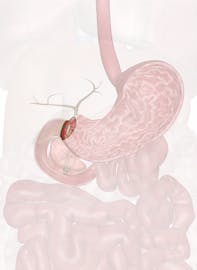The Pyloric Sphincter
Explore the anatomy and role of the pyloric sphincter in digestion with Innerbody's interactive 3D model.

The pyloric sphincter is a band of smooth muscle at the junction between the pylorus of the stomach and the duodenum of the small intestine. It plays an important role in digestion, where it acts as a valve to controls the flow of partially digested food from the stomach to the small intestine.
Anatomy
The pyloric sphincter is a thin, circular band of visceral muscle surrounding the pyloric opening at the inferior end of the stomach. It is found at the border of the stomach's final segment, the pylorus, and the small intestine's first segment, the duodenum. The pylorus is tapered and funnel-shaped, narrowing from the wide body of the stomach to only about an inch in diameter at the pyloric sphincter.
Physiology
The pyloric sphincter plays important roles in controlling the rate of digestion and the direction of chyme movement in the gastrointestinal tract. Food in the stomach is mixed with gastric juice produced by the stomach to form a thick, acidic liquid called chyme. Following a meal, the stomach stores chyme both to begin its digestion and to allow the rest of the digestive system enough time to digest the food thoroughly. The pyloric sphincter remains closed during eating and while the stomach mixes food with gastric juice to form chyme.
After the stomach has completed its digestive role, the pyloric sphincter begins to convulse in waves of peristalsis to push chyme toward the pylorus. As each peristaltic wave reaches the pylorus, the pyloric sphincter briefly opens to permit a small mass of chyme to pass into the duodenum. Wave after wave of peristalsis slowly empty the stomach over a period of about 30 minutes to an hour.
The pyloric sphincter prevents the regurgitation of chyme from the duodenum into the stomach. It also controls the flow of chyme into the intestine, which provides the intestines with a manageable volume of chyme from which to absorb nutrients.


